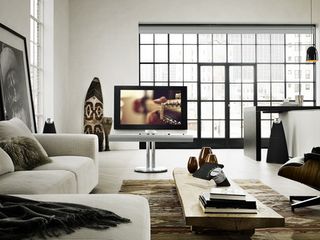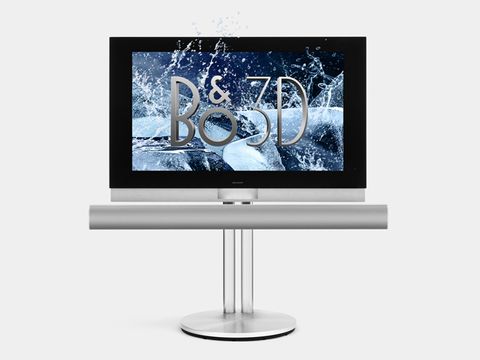Why you can trust TechRadar
Switch the Bang & Olufsen BeoVision 7-40 on and the 'digital curtains' part. Ahhh, that's nice. Even better, when it's turned-off the curtains close, slowing in the middle for a protracted 'kiss'.
In between those effects, the buzzword is Automatic Picture Control. Aside from simple up-and-downs for contrast, brightness and colour - as well as a useful Games mode - the picture quality is taken care of automatically, through a combination of pre-loaded parameters and a light sensor that adjusts the backlight intensity and panel brightness.
It is possible to access a slightly hidden customer service menu that enables tweaks of the sharpness, local dimming, film judder (switched on by default) and dynamic contrast (ditto), but the tweaks are few and far between.
Luckily the Bang & Olufsen BeoVision 7-40's panel is natively high quality and well tuned from the box, so a lot of tweaking isn't strictly necessary. Fitted with an effective anti-reflection coating, the Edge LED panel is always of even brightness and offers deep black levels, though its key characteristic is versatility.

As deep and convincing as on any such panel we've seen, there's plenty of shadow detail within, while the brighter elements of the image are both sharp and clean.
Aside from skin tones, which can appear a little rich at times, the cleanliness of 2D sources most impressed us. Some broadcasts on BBC One HD enjoyed spotless backgrounds, with none of the picture noise evident on rival panels, while standard definition sources, too, retained their wholeness and fluidity.
Fast-moving footage is handled relatively well, too, with little in the way of motion blur.
Turn to 3D from the built-in Blu-ray player and it's the usual story, with LED-based dimension hopping. The active shutter tech produces a lot of detail, but despite an overall watchable image, there are significant problems with viewing in 3D for more than a few minutes.

We'll skip over the fact that the fairly wide active shutter 3D specs tend to house reflections from other light sources (and produce flicker from fluorescent lights nearby), and will instead concentrate on some of the scenes from Ultimate Wave Tahiti.
A close-up shot of two people talking on a beach features a stutter and blur as they move their heads, and they both appear as cardboard cut-outs against the background.
Soon after, a shot of a surfer features some awesome 3D effects until the director pushes it too far and a splash of water against the camera is just impossible for our eyes to make sense of.
Despite those innate problems with 3D production, the Bang & Olufsen BeoVision 7-40 puts in a decent performance.

Crosstalk is rare - we noticed it only fleetingly during a dark scene of flame twirling against a pitch-black background - and the picture is relatively bright throughout, which isn't always the case with 3D plasmas.
A very wide bezel - a design faux pas for mainstream brands - is stoically clung to by Bang & Olufsen, which may be surprising, but it's done for good reason.
As well as helping the viewer perceive deeper contrast on the screen, that black strip also helps divorce the on-screen action from the surroundings - and for 3D, that's crucial.
Still, we'd judge this TV to be too small for genuinely immersive 3D.
Jamie is a freelance tech, travel and space journalist based in the UK. He’s been writing regularly for Techradar since it was launched in 2008 and also writes regularly for Forbes, The Telegraph, the South China Morning Post, Sky & Telescope and the Sky At Night magazine as well as other Future titles T3, Digital Camera World, All About Space and Space.com. He also edits two of his own websites, TravGear.com and WhenIsTheNextEclipse.com that reflect his obsession with travel gear and solar eclipse travel. He is the author of A Stargazing Program For Beginners (Springer, 2015),


